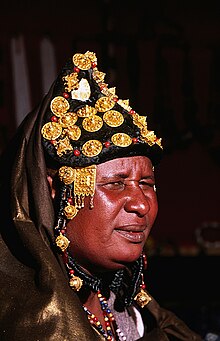Melhfa

Melhfa, also known as Toungou, Toub, Tassaghnist, Lafaya, or Dampé, is a traditional cloth commonly found across the Sahel and Sahara regions of Africa. The melhfa is a long rectangular cloth, typically measuring 4.5 meters by 1.6 meters, skillfully wrapped around the wearer's head and body.
It traditionally served as a means of protection from the harsh weather of the region and is typically made from natural fabrics such as cotton.[1][2][3]
Etymology
The Melhfa has different names in the various languages of the region. Across the Maghreb, it is known as melhfa (sometimes spelled Melfha, melafa, meulfeu, or mlahef). In Mauritania and Mali, it is referred to as dampé, while in Northern Nigeria (Arewa), Niger, and Chad, it is known as lafaya.[4] The Songhai people call it toungou, and among the Tuareg, it goes by the name tassaghnist. In Sudan, it is known as toub or tiyyab.[5]
Cultural Origins
Originating in the 11th century, the melhfa is a traditional garment worn by women in the Sahel and Sahara regions of Africa.[6] This flowing veil measures approximately 4.5 meters in length and 1.6 meters in width. Melhfas come in various styles – some reserved for festivals and ceremonies, while others are worn for daily activities. The melhfa wraps gracefully from head to toe, offering comfort in the desert's harsh conditions, with designs specifically crafted to endure the hot, dry climate and shield against cold, sand, and sun. It is an airy and roomy garment.[7][8]
Among Songhai women, the melhfa, known as toungou in the Songhai language, is worn with traditional headwear such as the goffa, sorgou-sorgou, hilo-hilo, and Zumbu. [9]

Use
In recent years, the Melhfa has become increasingly adorned with intricate embroidery, prominently displayed along its edges or as a pattern on the front or back of the garment. This embellishment, often executed in vibrant colors and geometric shapes, serves as a testament to the artisanal skill involved. The Melhfa has gained considerable popularity in contemporary times, making appearances in fashion shows and being donned by celebrities. This visibility has contributed to heightened awareness of the cultural and craftsmanship elements associated with this garment. [10]
Furthermore, in recent years, there has been a notable evolution in the Melhfa’s design and fabric composition. Modern influences have been incorporated into this traditional attire, reflecting the changing tastes and preferences of younger generations. This adaptation underscores the garment's ability to endure and remain relevant in the dynamic landscape of contemporary fashion.[11]
References
- ^ The Traditional Wrap: Toub, Melhfa, Lafaya, Tiyyab..., sonjiki.co.uk, retrieved 2024-01-14
- ^ El melhfa, Traditional women's clothing of the saharan Morocco, 2014, retrieved 2024-01-14
- ^ Toub unifies women from all tribes in Sudan, CGTN, 2022, retrieved 2024-01-14
{{citation}}: CS1 maint: location missing publisher (link) - ^ This Traditional Bridal Shoot will make You Fall in Love with the Beauty of Nigerian Culture, BellaNaija, 2019, retrieved 2024-01-14
{{citation}}: CS1 maint: location missing publisher (link) - ^ Sudanese women demonstrate in support of civilian rule, sudantribune.com, 2022, retrieved 2024-01-14
{{citation}}: CS1 maint: location missing publisher (link) - ^ Abba, Agaila (2016), This Classic Fabric Symbolizes Beauty And Resistance For Saharawi Women, okayafrica.com, retrieved 2024-01-14
{{citation}}: CS1 maint: location missing publisher (link) - ^ The Melhfa, traditional finery, wikichallenge.fondationorange.com, retrieved 2024-01-14
- ^ Mouhou, Brahim (2021), The melhfa, women’s clothing in Morocco, retrieved 2024-01-14
- ^ INITIATION À 3 COIFFURES D’INSPIRATION SONGHAÏ AVEC OUDI by SALI, 2021, retrieved 2023-12-16
- ^ Al malahfa, retrieved 2024-01-14
- ^ The Traditional Wrap: Toub, Melhfa, Lafaya, Tiyyab..., sonjiki.co.uk, retrieved 2024-01-14
